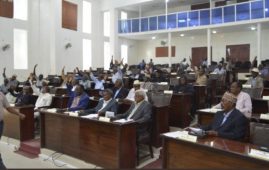Unlike the local media, the World Wide Web had a stream of updates on Ethiopia’s potash reserves for about a year or so. Those were press releases by companies engaged in potash exploration in Ethiopia and apparently targeting shareholders, stockbrokers and market analysts – as their content and presentation suggests.![[Danakil Basin - Ethiopia] Yara International, Ethiopotash, Allana potash estimate billions of tones deposit [Danakil Basin - Ethiopia] Yara International, Ethiopotash, Allana potash estimate billions of tones deposit](https://hornaffairs.com/wp-content/uploads/2012/06/danakil-basin-ethiopia-yara-international-ethiopotash-allana-potash-estimate-billions-of-tones1.jpg)
The major players are Allana Potash and Yara International, according to a brief on A Week in the Horn last month. It stated:
New investments underline the possibility that the Danakil Basin is going to develop into a significant international source of potash, a main source for fertilizer.
Yara International, a Norwegian fertilizer group and the world largest supplier of potash has decided to increase its stake in Ethiopotash, a firm working to exploit the potash deposits in the Depression, from 16 percent to 51%. The preliminary estimates last November were for the capacity to produce 1 million to 1.5 million tonnes a year of potash from resources that will last for about 30 years. The results exceeded the expectations of management and this led to Yara’s decision to increase its stake in Ethiopotash.
Yara’s sign of confidence in the potash prospects from the region will also be welcomed by Allana Potash which is currently working a concession adjacent to Yara’s Dallol site.
Allana has also recently announced a considerable increase, of some 90%, in its mineral resource estimates. The measured and indicated mineral resources are now calculated as a total of 1.3 billion tonnes with an average grade of 19.32% Potassium Chloride (KCL) representing approximately 250 millions of tonnes of KCL. Last November, the preliminary economic assessment of the project suggested an internal rate of return of 36.8% and a net present value of US$1.85 billion, based on a 12% discount rate.
The Dallol project is said to have a significant advantage over potash projects in other parts of the world, especially compared to the production in Saskatchewan in Canada, since it has “one of the lowest capex and opex in the world” in the potash industry.
The optimism is shared by Steve Hansen, an equity analyst at Raymond James.
In an interview with The Energy Report, Hansen affirmed that ‘Ethiopia is blessed with a high-grade, relatively shallow, world-class potash deposit in the Danakil basin,…very well positioned geographically to service some of the world’s highest-growth markets for potash, with relatively short shipping distances from Africa’s eastern coast’.
However, the equity analyst quickly adds, ‘the principal challenge for the basin pertains to the country’s relatively undeveloped infrastructure……Over time, the Danakil will certainly be developed a few more things need to fall into place before large-scale development can take off’.
Hansen also commented on a issues related to the current potash market, the companies exploring in Ethiopia and the like.
Here are excerpts from the interview published on The Energy Report on June 1, 2012.
*********
The Energy Report: Potash prices and production collapsed in 2008. Why is Raymond James still bullish on potash?
Steve Hansen: It is a relatively simple supply-demand thesis. On the demand front, global food consumption is growing steadily alongside population growth, urbanization, rising disposable income and shifting dietary patterns—particularly in emerging markets. According to the FAO, global food production needs to increase by 70% by 2050 just to keep the world adequately fed. That’s an enormous uplift compared to current levels. We view higher rates of fertilizer application, especially potash, as one of the key factors in achieving these necessary production gains.
On the supply side, global potash reserves and production capacity are concentrated in the hands of just a few key players. The world’s top-five producers account for two-thirds of global potash capacity. The immense capital requirements needed to develop new mines present significant barriers to entry. This combination of concentration and capital creates an attractive supply-controlled environment; it allows the incumbent producers to extract favorable pricing.
The Energy Report: What countries are the major users and/or exporters of potash products? Which countries produce enough for their own consumption, and which are import dependent?
Steve Hansen: The largest exporters are Canada and Russia, where more than 70% of global potash reserves are concentrated and the largest incumbent producers are also based. The largest consuming nations are China, the U.S., Brazil and India, all of which have large, agriculturally influenced economies. The largest consumers are also the largest importers, although, in some instances, importers do have material amounts of domestic production. The obvious cases are the U.S. and China, both of which have fairly sizeable domestic potash industries that help reduce the amount of required imports. On the other end of the spectrum are Brazil and India. Because both have very little domestic production, they must rely almost entirely upon international imports.
The Energy Report: Ethiopia has been a source of potash since the 14th century. In late 1960s, floods shut down potash production, and then war and internal strife kept the mines closed. How has this situation changed? Is the Ethiopian government friendly to foreign mining investment? Is it stable?
Steve Hansen: Ethiopia is blessed with a high-grade, relatively shallow, world-class potash deposit in the Danakil basin, which is located in the northeast near the Eritrean border. It’s very well positioned geographically to service some of the world’s highest-growth markets for potash, with relatively short shipping distances from Africa’s eastern coast. However, from our perspective, the principal challenge for the basin pertains to the country’s relatively undeveloped infrastructure. It’s still lacking in a lot of key roadways, rail, and power infrastructure. There are a
lso key technical issues around water availability that still need to be addressed. The Ethiopian government has made significant progress on road development, however, having paved a large roadway into the southern side of the Danakil basin. The government has also contracted a Chinese state-owned railway group to build out the rail infrastructure. The early stages of this rail infrastructure are not headed into the Danakil, but there is the potential to extend rail there, which would be a huge win for the basin. Other large parties—Yara being a key example—are also making additional investments in the basin.
So the short answer is that Ethiopia still has clear challenges to overcome. But the quality and size of the resource is not to be ignored. Over time, the Danakil will certainly be developed, but a few more things need to fall into place before large-scale development can take off.
The one counterintuitive advantage Ethiopia has going for it is that developers in the country likely have access to capital from nontraditional sources, such as the International Finance Corporation and World Bank. Developers with projects in advanced countries, such as Canada, cannot access this type of capital. There are good examples of infrastructure-related projects—wind in particular—where the IFC and World Bank are already providing attractive financing terms to advance the economic development of Ethiopia. And we expect that potash developers in the Danakil basin likely have access to similar sources of capital. For example, Allana Potash Corp. has already struck very good financing arrangements on both the commercial and international banking fronts.
The Energy Report: Who has Allana partnered with?
Steve Hansen: On the equity side, Allana has received equity financing from Liberty Metals & Mining Holdings LLC. (a subsidiary of Liberty Mutual Insurance). Liberty is a large, sophisticated group with a great deal of mining interests around the world. The World Bank-affiliated International Finance Corp. has also taken an equity stake in Allana. This was a critical accomplishment for the company’s credibility. Thanks to a recent equity raise, it is now fully funded through its definitive feasibility study (DFS). The one key piece of the financing puzzle still to be completed is on the debt side, but this likely won’t occur until the project’s DFS is completed later this year. At that point, presuming everything goes to plan, the company will need to raise one last tranche of equity to finance construction. The big question for Allana is what percentage will go into debt versus equity? Typically, it’s a 60/40 or 70/30 split. But Allana may be able to raise the ratio even higher, perhaps even 80% debt, given its access to development agency financing. It just needs to address key technical issues that are still outstanding.
The Energy Report: Are there other players operating in the Danakil basin?
Steve Hansen: Yara has a partnership in the basin. South Boulder Mines Ltd. is on the Eritrean side of the border. And Ethiopian Potash Corp. has a deposit. BHP also has a large concession in the basin, although it hasn’t been too active there of late.
The Danakil footprint is well mapped out. It is a world-class deposit, with attractive attributes. Multiple parties are expressing interest in it. The big question remains: Is it the easiest deposit to develop in the current context, versus other opportunities?
* Steve Hansen joined the Raymond James investment firm in October 2005 as an associate equity analyst covering the industrial sector. He was promoted to equity analyst in April 2007. Prior to joining the firm, Hansen worked as a stock analyst with Morningstar, covering the forest products sector. Hansen holds a Master of Business Administration from the Ivey School of Business at the University of Western Ontario and a Bachelor of Science in forestry from the University of British Columbia. Steve also holds a CMA designation and is a CFA Charter holder.
************
Check the drop down menu at the top for related posts.





